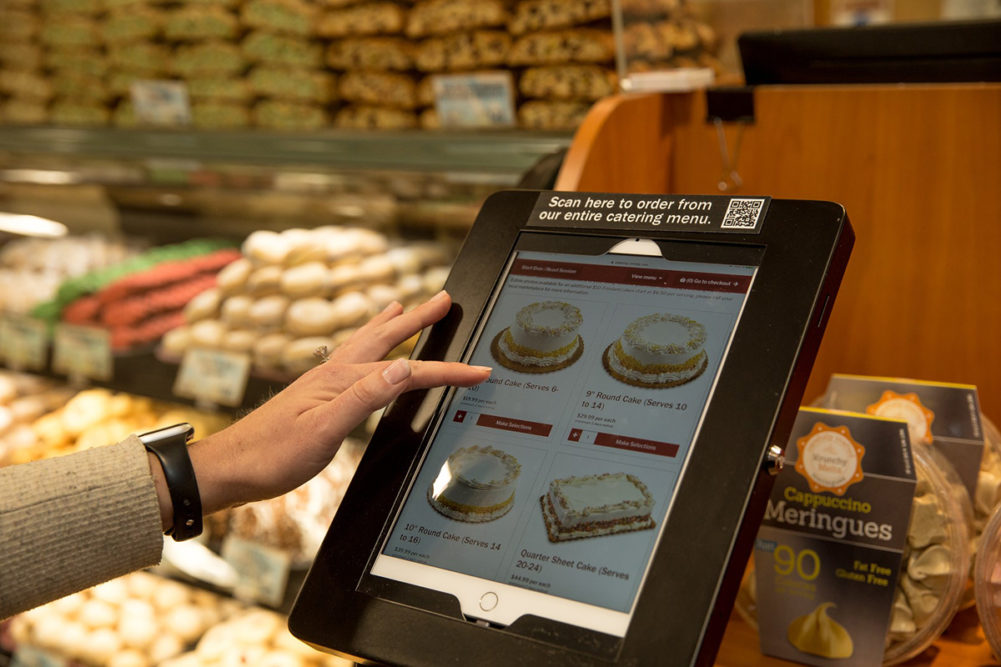The use of self-ordering kiosks is gaining ground quickly in retail foodservice and other fresh perimeter departments.
Self-service transaction systems specialist Diebold Nixdorf forecasts continued high demand for kiosks and other automation solutions at retail, whether it’s at checkout or in other parts of the store where they can generate higher customer loyalty or streamline the fulfillment process, said Nino Hoerttrich, the company’s head of global marketing, retail.
“Retailers leverage the ordering terminals to waiting lines, give customers additional ordering options, show more detailed product information and ensure a seamless customer experience,” Hoerttrich said.
Kiosks can also reduce the number of tasks for employees, he added, so that employees can focus on order fulfillment and other tasks.
In addition to placing or picking up retail foodservice orders, kiosks work great in instore bakeries for customized cake or cookie orders, among many other uses, Hoerttrich said.
Another big reason more and more grocery stores are turning to in-store kiosks is the prevention of errors that are common when manual ordering and other processes are used.
“The customized cake ordering process is a great example,” Hoerttrich said. “Entering requests into a system instead of writing them down on a piece of paper before passing them along to the kitchen gives customers more time to select between all options and avoids misunderstandings at the ordering counter or even in the kitchen when trying to decipher hand-written notes.”
And considering the tight labor market, automation means that employees can devote the time that in the past would have spent doing manual orders doing other, more productive things.
Another great reason for putting in-store kiosks in perimeter departments is the opportunity to upsell.
The average basket size increases by up to 30% when customers select from a kiosk menu, Hoerttrich said.
With a kiosk, they don’t have to feel uncomfortable about other, perhaps impatient, people waiting in line behind them. And the kiosk automatically gives them item recommendations to help speed their orders.
In addition to food ordering, kiosks are also being used by grocers for other self-service options like giving customers instant access to recipe libraries or product recommendations (What wine goes with what kind of fish or meat, for example). Kiosks can also provide an “endless aisle” experience for people to order sold-out items for home delivery.
Diebold Nixdorf’s kiosks are highly modular, Hoerttrich said, which allows for various configurations including different screen sizes, side attachments like scales or basket shelves and optional cash or non-cash payment integration.
And all are based on a single platform.
In addition, the openness to integrate into various POS applications and partner software applications makes the Diebold Nixdorf portfolio very attractive to retailers and differentiates the company from most of its competitors, Hoerttrich said.
A holistic solution
FoodStorm’s OMS technology offers a holistic solution for grocery retailers to manage their prepared foods, catering, made to order meals, deli and bakery departments, said Rob Hill, general manager, Order Ahead, at Instacart, which owns FoodStorm.
“FoodStorm’s solution supports omnichannel ordering, online and in-store, while the backend OMS technology supports retailers in streamlining the production and management of those orders.”
The FoodStorm kiosk solution, he added, is part of an in-store ordering suite that allows retail customers to simply and easily order ahead from any fresh counter in the store.
And it’s used in various departments of the grocery store. Catering departments, for instance, use it for holiday meal ordering; delis for pre-orders of meat, cheese and prepared foods; and bakeries for custom cakes.
Kiosks are also often found in retail foodservice sections, where shoppers can order sandwiches, pizza and other made-to-order meals, Hill said.
“What’s great about FoodStorm is that it provides retailers with the flexibility to install as many kiosks and menus as needed. All orders are seamlessly directed to the corresponding kitchen display system in the appropriate department, helping store associates fulfill orders with ease.”
There is no other built-for-grocery, fresh food OMS, Hill added, that has the feature depth of FoodStorm, which has the ability to integrate into Instacart App, Caper Carts, Instacart’s Last Mile Delivery and other services.
The company’s kiosk software seamlessly connects grocers to a powerful suite of order management tools, including departmental order management, an intuitive kitchen display system, instant publishing and a central order repository.
“These tools ensure real-time information flow across departments, offering a comprehensive and efficient solution.” FoodStorm is designed to work seamlessly with any kiosk hardware or tablet device, making it even easier to integrate with a retailer’s existing operations or preferred setup.”
Adaptability is a key factor, he added, in providing retailers with a flexible and tailored solution to meet their specific needs.
Why kiosks?
1. Customer demand for technology
Customers have become increasingly familiar and comfortable with self-service kiosks. There’s a growing expectation for the convenience and efficiency they offer.
2. Demand for more order-ahead options
Industry trends show a rising demand from customers for convenient and cost-effective prepared food options from grocery stores. Ordering kiosks provide an avenue for meeting this demand, offering customers more options to order ahead.
3. Labor shortages
Using ordering kiosks means customers don’t have to wait for an available associate to place their order, and it allows team members to focus on making and fulfilling orders.
4. Retailer differentiation
In a competitive market, retailers are driven to stand out and differentiate themselves. Offering customers more efficient service options, such as ordering kiosks, becomes key in meeting customer expectations and staying ahead in the market.
Source: Rob Hill, Instacart
This article is an excerpt from the March 2024 issue of Supermarket Perimeter. You can read the entire Kiosks feature and more in the digital edition here.

